Tswana people
The Tswana (Tswana: Batswana, singular Motswana) are a Bantu-speaking ethnic group who are native to Southern Africa. The Tswana language is a member of Sotho-Tswana language group which belongs to the Bantu language family group. Both Northern Sotho and Sesotho derive from the Setswana language and the people speaking these languages are an offshoot of the tswana people. Ethnic Tswana made up approximately 85% of the population of Botswana in 2011.[1]
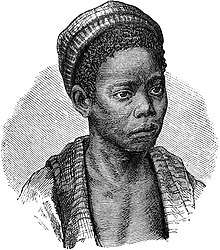 Motswana Bella (Young woman) | |
| Total population | |
|---|---|
| 7,107,500 | |
| Regions with significant populations | |
| c. 2 million[1] | |
| 5,000,000 (Tswana-speakers)[2] | |
| c. 10 000[3] | |
| c. 97 500[4] | |
| Languages | |
| Setswana, English | |
| Religion | |
| Christianity, African Traditional Religion. | |
| Related ethnic groups | |
| Sotho, Northern Sotho, Bakgalagari, Coloureds | |
| Tswana | |
|---|---|
| Person | Mostwana |
| People | Batswana |
| Language | Setswana |
| Country | Bostwana |
The Tswana are the native people of south-western Botswana, Gauteng, North West province of South Africa where the majority of the Tswana live. And some parts of Northern Cape.
History
Early history of Batswana
_(14796270283).jpg)
The Batswana are descended mainly from Bantu-speaking tribes who migrated southward of Africa around 600 AD, living in tribal enclaves as farmers and herders. Several Iron Age cultures flourished from around 900 AD, including the Toutswemogala Hill Iron Age settlement. The Toutswe were based in the eastern region of what is now Botswana, relying on Tswana cattle breed held in kraals as their source of wealth. The arrival of the ancestors of the Tswana-speakers who came to control the region (from the Vaal River to Botswana) has yet to be dated precisely although AD 600 seems to be a consensus estimate. This massive cattle-raising complex prospered until 1300 AD or so. All these various peoples were connected to trade routes that ran via the Limpopo River to the Indian Ocean, and trade goods from Asia such as beads made their way to Botswana most likely in exchange for ivory, gold and rhinoceros horn. Members of the Bakwena, a chieftaincy under a legendary leader named Kgabo II, made their way into the southern Kalahari by AD 1500, at the latest, and his people drove the Bakgalagadi inhabitants west into the desert. Over the years, several offshoots of the Bakwena moved into adjoining territories. The Bangwaketse occupied areas to the west, while the Bangwato moved northeast into formerly Bakalanga areas. Not long afterwards, a Bangwato offshoot known as the Batawana migrated into the Okavango Delta, probably in the 1790s. The first written records relating to modern-day Botswana appear in 1824. What these records show is that the Bangwaketse had become the predominant power in the region. Under the rule of Makaba II, the Bangwaketse kept vast herds of cattle in well-protected desert areas, and used their military prowess to raid their neighbours. Other chiefdoms in the area, by this time, had capitals of 10,000 or so and were fairly prosperous. One of these famous capitals was Kaditshwene which was the cultural capital of the Bahurutshe people, one of the principal Tswana tribes and a centre of manufacturing and trading, it had been founded in the late 1400s on the site of iron and copper ore deposits. This equilibrium came to end during the Mfecane period, 1823-1843, when a succession of invading peoples from South Africa entered the country. Although the Bangwaketse were able to defeat the invading Bakololo (Sotho-Tswana speaking Clan) in 1826, over time all the major chiefdoms in Botswana were attacked, weakened, and impoverished. The Bakololo and amaNdebele raided repeatedly, and took large numbers of cattle from the Batswana—most of whom were driven into the desert or sanctuary areas such as hilltops and caves. Only after 1843, when the Amandebele moved into western Zimbabwe, did this threat subside.[5][6]
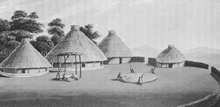
According to all historical narratives to date, Barotseland, or rather the Luyi state or nation, was invaded sometime between 1820 and 1840 by a branch of Sotho-Tswana peoples that the Luyi originally referred to as the Akubu, later known as the Makololo led by their warrior charismatic leader, Sibituane a wise military strategist, occupying it and imposing their will for over thirty years, until they were overthrown in 1864. The Makololo were in fact the Bafokeng Basotho(Mixture of Sotho and Tswana) people that moved from the then Orange Free State area through modern day Botswana upnorth to the present day southern Zambia. From the 1820s to the 1860s, the name Makololo inspired a combination of fear, horror and reverence amongst peoples of the Kalahari between the Orange and Zambezi Rivers. The name Makololo only came about during the long migration north. One version has it that the name came about after Sibituane took a wife named Setlutlu of the Batlokoa (Tswana Clan), who he had previously awarded to Lechae, one of his young commanders but who he was particularly enamoured with himself. Sibituane was renowned for his military capabilities and his leadership qualities. The very fact of so many victories for Sibituane over peoples who would have strongly resisted the transit of strangers through their lands suggests remarkable abilities. This led to considerable respect for Sibituane and the Makololo system of rule. In truth it was no contest and after a few battles the Lozi forces were completely routed although total subjugation of Barotseland took around five years to complete. Sibituane made his capital at Naliele but moved south again to Linyanti (present day Sangwali) in Caprivi where he met Livingstone and Oswell in 1851.[7][8][9][10]
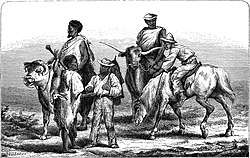
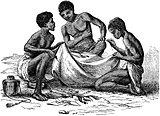
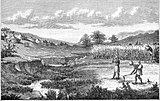
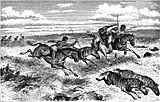
Batswana–Boer Wars

During the 1840s and 1850s trade with Cape Colony-based merchants opened up and enabled the Batswana chiefdoms to rebuild. The Bakwena, Bangwaketse, Bangwato and Batawana cooperated to control the lucrative ivory trade, and then used the proceeds to import horses and guns, which in turn enabled them to establish control over what is now Botswana. This process was largely complete by 1880, and thus the Bushmen, the Bakalanga, the Bakgalagadi, the Batswapong and other current minorities were subjugated by the Batswana. Following the Great Trek, Afrikaners from the Cape Colony established themselves on the borders of Botswana in the Transvaal. In 1852 a coalition of Tswana chiefdoms led by Sechele I resisted Afrikaner incursions which culminated with the pivotal showdown of the Battle of Dimawe fought with artillery and long range rifles as well as musket fire. Although it was the Boer Commando led by the Boer Commandant-General Pieter Scholtz and Paul Kruger, as an officer leading the Boer advance who started the offensive, it was they who ended up on the retreat followed by Batswana's retaliatory attacks into the then Transvaal's Marique district in which Boer settlements, villages and farms were scotched. After about eight years of intermittent tensions and hostilities, eventually came to a peace agreement in Potchefstroom in 1860. From that point on, the modern-day border between South Africa and Botswana was agreed on, and the Afrikaners and Batswana traded and worked together peacefully.[11]
Battle of Khutiyabasadi
The Batawana's (Tswana tribe/clan) fight against invading Ndebele of 1884. When the amaNdebele arrived at Toteng, they thus found the village abandoned. But, as they settled down to enjoy their bloodless conquest, about seventy mounted Batawana under Kgosi Moremi's personal command appeared, all armed with breech-loading rifles. In classic commando style the cavalry began to harass the much larger enemy force with lethal hit and run volleys. Meanwhile, another group of traditionally armed subjects of the Kgosi also made their presence known.
At this point the amaNdebele commander, Lotshe, took the bait dividing his army into two groups. One party pursued Moremi's small force, while the other fruitlessly tried to catch up to what they believed was the main body of Batawana.
As the invaders generally lacked guns, as well as horses, Moremi continued to harass his pursuers, inflicting significant casualties while remaining unscathed.
The primary mission of Moremi's men was not, however, to inflict losses on the enemy so much as to ensnare them into a well designed trap. His force thus gradually retreated northward towards Khutiyabasadi, drawing the amaNdebele to where the main body of defenders were already well entrenched.
As they approached the swamp area south Khutiyabasadi, Lotshe struggled to reunite his men, perhaps sensing that they were approaching a showdown. But, instead, Moremi's Batawana, now joined by Qhunkunyane's Wayeyi drew the amaNdebele still deeper into the swamps.
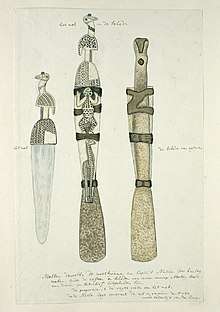
In this area of poor visibility, due to the thick tall reeds, the Batawana and Wayeyi were able to employ additional tricks to lure the invaders towards their ultimate doom. At one point a calf and its mother were tied to separate trees to make Lotshe's men think that they were finally catching up to their main prize, the elusive Batawana cattle. As they pressed forward the amaNdebele were further unnerved by additional hit and run attacks and sniping by small bands of Batawana marksmen. Certainly they could not have been comfortable in the unfamiliar Okavango environment.
It was at Kuthiyabasadi that the defenders' trap was finally sprung. At the time, the place was an island dominated by high reeds and surrounded to the west by deep water. In the reeds, three well armed Batawana regiments, joined by local Wayeyi, waited patiently. There they had built a small wooden platform, upon which several men could be seen from across the channel, as well tunnels and entrenchments for concealment. The amaNdebele were drawn to the spot by the appearance of Batawana cavalry who crossed the channel to the island in their sight. In addition, cattle were placed on a small islet adjacent to Kuthiyabasadi, while a group of soldiers now made themselves visible by standing up on the wooden platform. Also at the location was a papyrus bridge that had been purposely weakened at crucial spots. Surveying the scene, Lotshe ordered his men to charge across the bridge over what he presumably thought was no more than a small stream. As planned, the bridge collapsed when full of amaNdebele, who were thus unexpectedly thrown into a deep water channel. Few if any would have known how to swim.
Additional waves of amaNdebele found themselves pinned down by their charging compatriots along the river bank, which was too deep for them to easily ford. With the enemy thus in disarray, the signal was given for the main body of defenders to emerge from their tunnels and trenches. A barrage of bullets cut through Lotshe's lines from three sides, quickly turning the battle into a one-sided massacre. It is said that after the main firing had ceased, the Wayeyi used their mekoro to further attack the survivors trapped in the river, hitting them on the head with their oars. In this way, many more were drowned. By the time the fighting was over, the blood is reported to have turned the water along the course of the river black. While the total number of casualties at Khutiyabasadi cannot be precisely known, observers in Bulawayo at the time confirm that over 2,500 men had left on Lotshe's expedition and less than 500 returned. While the bulk of the amaNdebele losses are believed to have occurred in and around Khutiyabasadi itself, survivors of the battle were also killed while being mercilessly pursued by the Batawana cavalry. Moremi was clearly determined to send a strong message to Lobengula that his regiments were no match. Still others died of exhaustion and hunger while trying to make their way home across the dry plains south of Chobe; the somewhat more hospitable route through Gammangwato having been blocked by Khama. While the battle at Khutiyabasadi was a great victory for the Batawana and defeat for the amaNdebele, for the Wayeyi of the region the outcome is said to have been a mixed blessing. While they had shared in the victory over the hated Amandebele, one of its consequences was a tightening of Batawana authority in the area over them, as Moremi settled for a period at nearby Nokaneng.[12]
First Matabele War
The First Matabele War was fought between 1893 and 1894 in modern-day Zimbabwe. The British South Africa Company had no more than 750 troops in the British South Africa Company's Police, with an undetermined number of possible colonial volunteers and an additional 700 Tswana (Bechuana) allies who marched on Bulawayo from the south commandeered by Khama III, the most influential of the Batswana chiefs, and a staunch ally of the British. The Salisbury and Fort Victoria columns marched into Bulawayo on 4 November 1893. The Imperial column from Bechuanaland was nowhere to be seen. They had set march on 18 October heading north for Bulawayo and had a minor skirmish with the Matabele near Mphoengs on 2 November. They finally reached Bulawayo on 15 November, a delay which probably saved the Chartered Company's then newly occupied territory being annexed to the imperial Bechuanaland Protectorate.[13]
Bophuthatswana
.svg.png)
The Bophuthatswana Territorial Authority was created in 1961, and in June 1972 Bophuthatswana was declared a self-governing state. On 6 December 1977 this 'homeland' was granted independence by the South African government. Bophuthatswana's capital city was Mmabatho and 99% of its population was Tswana speaking. In March 1994, Bophuthatswana was placed under the control of two administrators, Tjaart van der Walt and Job Mokgoro. The small, widespread pieces of land were reincorporated into South Africa on 27 April 1994. Bophuthatswana is part of the North West Province under Premier Prof Job Mokgoro. On 9 May 2018, Mahumapelo, who was Premier before Prof Mokgoro, announced that he would take leave of absence and appointed Finance MEC Wendy Nelson as acting premier. President Cyril Ramaphosa appointed an inter-ministerial task team to investigate violent protests in the province's capital Mahikeng and other towns through the province over a long period of time. Supra Mahumapelo officially resigned on 23 May 2018.
Dynasties and tribes
Botswana

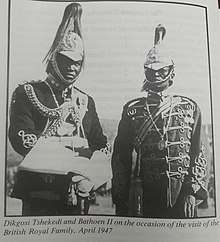
The republic of Botswana (formerly the British protectorate of Bechuanaland) is named for the Tswana people. The country's eight major tribes/Clans speak Tswana, which is also called Setswana. All have a traditional Paramount Chief, styled Kgosikgolo, who is entitled to a seat in the Ntlo ya Dikgosi (an advisory body to the country's Parliament). The Tswana dynasties are all related. A person who lives in Botswana is a Motswana and the plural is Batswana.[14][15] The three main branches of the Tswana tribe formed during the 17th century. Three brothers, Kwena, Ngwaketse and Ngwato, broke away from their father, Chief Malope, to establish their own tribes in Molepolole, Kanye and Serowe, probably in response to drought and expanding populations in search of pasture and arable land.[16]
The principal Tswana tribes/Clans are the:
South Africa
The largest number of ethnic Tswana people actually live in South Africa. They are one of the largest ethnic groups in the country, and the Tswana language is one of eleven official languages in South Africa. There were over 4 million Tswana speakers in the country in 2012,[2] with North West Province having a majority of 2,200,000 Tswana speakers. From 1948 to 1994, South African Tswana people were defined by the Apartheid regime to be citizens of Bophuthatswana, one of ten bantustans set up for the purpose of defending the policy of denying black Africans citizenship in South Africa.
- Batswana in South Africa
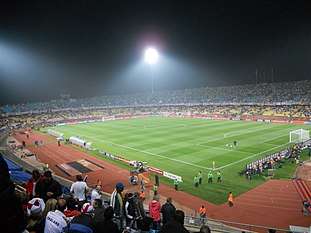 Royal Bafokeng Stadium owned by Bafokeng.
Royal Bafokeng Stadium owned by Bafokeng.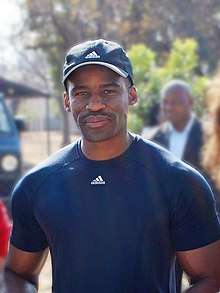 kgosi Molotlegi Chief of Bafokeng.
kgosi Molotlegi Chief of Bafokeng.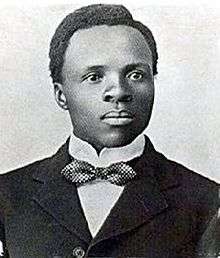 Sol Plaatje (1876 – 1932) Author, ANC Founding Member,intellectual & linguist, .
Sol Plaatje (1876 – 1932) Author, ANC Founding Member,intellectual & linguist, . Barolong chief Molema, 1815-1896.
Barolong chief Molema, 1815-1896.
Setswana food and cuisine
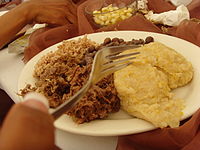

Bogobe is a porridge made from sorghum or millet which can be prepared differently to make various porridges. The most popular sorghum porridge is Ting.[17] Bogobe jwa Logala/Sengana is a traditional Setswana dish prepared from sorghum porridge mixed/cooked with milk. Seswaa is Botswana's national dish and is often served at weddings, funerals, and other celebrations. Seswaa is a pounded or shredded meat and often served with Bogobe (Porridge). Madila is a sour cultured milk a primitive form of cheese curd prepared from cow and goat milk over a period of time until fully matured for consumption. Traditionally madila were prepared using Lekuka a leather sack or bag used in processing and storing madila. Madila is also traditionally used as relish, eaten with pap. It can also be used in popular Tswana breakfast meal, motogo, to give the soft porridge that sour and milky taste.
Culture and attire
Batswana wear a cotton fabric known in Setswana as Leteishi and Sotho as Shweshwe. This fabric is often used for wedding celebrations and other traditional celebrations. In Setswana tradition mothers wear mogagolwane, a checkered small blanket during traditional baby-showers, and married women during traditional weddings are identified by it, as well as during various initiation ceremonies. Even during funerals Batswana women don mogagolwane.
Music
Tswana music is mostly vocal and performed, sometimes without drums depending on the occasion; it also makes heavy use of string instruments. Tswana folk music has instruments such as Setinkane (a Botswana version of miniature piano), Segankure/Segaba (a Botswana version of the Chinese instrument Erhu), Moropa (Meropa -plural) (a Botswana version of the many varieties of drums),and phala (a Botswana version of a whistle used mostly during celebrations, which comes in a variety of forms). Botswana cultural musical instruments are not confined only to the strings or drums. the hands are used as musical instruments too, by either clapping them together or against phathisi (goat skin turned inside out wrapped around the calf area; it is only used by men) to create music and rhythm. For the last few decades, the guitar has been celebrated as a versatile music instrument for Tswana music as it offers a variety in string which the Segaba instrument does not have. Other notable modern Tswana music is Tswana Rap known as Motswako.[18]
Visual arts

Batswana are noted for their skill at crafting baskets from Mokola Palm and local dyes. The baskets are generally woven into three types: large, lidded baskets used for storage, large, open baskets for carrying objects on the head or for winnowing threshed grain, and smaller plates for winnowing pounded grain. Potters made clay pots for storing water, traditional beer and also for cooking and hardly for commercial use. Craft makers made wooden crafts and they made traditional cooking utensils such as leso and lehetlho, traditional wooden chairs and drums among others.[19]
Tswana astronomy

Astronomy is an old age tradition in Africa. As with all other cultures, various ethnic groups developed their own interpretations of the solar system. Using their natural instrument the eye, Batswana have observed, commented on and named celestial objects of interest to them. There are more telling and specific names that relate to unique stellar patterns and their seasonal appearance e.g. Selemela, Naka, Thutlwa, and Dikolojwane. According to Tswana culture, the stars of Orion's sword were "dintsa le Dikolobe", three dogs chasing three pigs of Orion's belt. The Milky Way was viewed by the Tswana as Molalatladi, the place where lightning rests. It was further believed that this place of rest also kept the sky from collapsing and showed the movement of time. Some even claimed that it turned the sun to the east, in a way to explaining the rising of the sun. It was also believed that it was a supernatural footpath across the sky along which ancestors' spirits walked. The moon (Ngwedi) is said to represent a woman; it brings forth light but not as scorching as the Sun (Letsatsi) and its light is associated with happiness. Venus is called Mphatlalatsana (the brilliant and blinding one) by Batswana & Kopadilalelo (seeker of evening meals). The southern African calendar was made up of 354 days, (12 x 29.5 day lunar month). This was 11 days shorter than the solar year, an issue which could not be ignored. The solution was to add an additional month, when necessary, to "catch up". Some years were 12 months long, others 13. After the arrival of Europeans and the introduction of the Gregorian calendar, it was noted that the Batswana people had started forgetting the name of the 13th month. In contrast to Europe, where the new year is in the middle of winter, in southern Africa it logically started in September or October at the start of the new growing season. Raditladi Basin, a large peak ring impact crater on Mercury with a diameter of 263 km is named after Leetile Disang Raditladi. a Motswana playwright and poet. [20] [21]
List of Notable Batswana and people of Tswana descent
- Notable people

_(cropped).jpg)
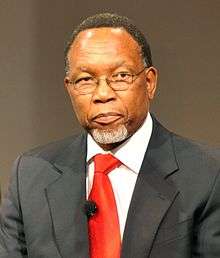



_(cropped).jpg)
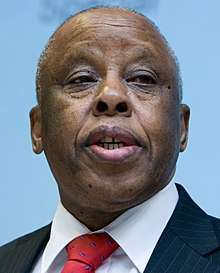

.jpg)
_(cropped).jpg)
.jpg)
Activism, authorship, academics and science
- Prof Dan Kgwadi - Vice chancellor, North-West University
- Keorapetse Kgositsile - South African ANC activist, writer, author.
- Z. K. Matthews - Academic in South Africa, lecturing at University of Fort Hare in 1955
- Thebe Medupe - Physics professor at North West University
- Dr. Matshidiso Moeti - Regional Director of the WHO Regional Office for Africa
- Mamokgethi Phakeng - Vice Chancellor of University of Cape Town
- Sol Plaatje - South African ANC activist, writer, author.
Politics, Royality, Activisim, Business and economics
- Bathoen I - Former Kgosi (paramount chief) of the Ngwaketse
- Frances Baard - Organiser of the African National Congress (ANC) Women's League and Trade Unionist
- Manne Dipico - first premier of Northern Cape province, South Africa
- Unity Dow - Botswana former High Court judge, author, activist, Minister
- John Taolo Gaetsewe - Trade unionist, member of the ANC and General Secretary of SACTU, Robben Island prisoner, banned person
- Khama III - King of Botswana
- Seretse Khama - First President of Botswana
- Ian Khama - Fourth President of Botswana
- Moses Kotane - South African politician and activist
- David Magang - Botswana lawyer, businessman and politician
- Supra Mahumapelo - South African politician
- Mmusi Maimane - South African politician
- Toto Makgolokwe - Paramount chief (kgosi) of the Batlharo tribe of South Africa
- Lucas Mangope - Former President of Bophutatswana
- Quett Masire - Second President of Botswana
- Mokgweetsi Masisi - President of Botswana
- Joe Matthews - South African politician
- Naledi Pandor (née Matthews) - South African politician and minister
- Festus Mogae - Third President of Botswana
- Mogoeng Mogoeng - Chief Justice, South Africa
- Job Mokgoro - South African politician and academic
- Yvonne Mokgoro - Former South African Constitutional Court Justice
- Popo Molefe - first premier of North West province, South Africa
- Edna Molewa - South African politician
- Leruo Molotlegi - King of the Royal Bafokeng Nation
- Ruth Mompati - South African political activist
- Nthato Motlana - Prominent South African businessman, physician and anti-apartheid activist
- Kgalema Motlanthe - South African politician, served as interim President of South Africa
- Bridgette Motsepe - South African businesswoman
- Patrice Motsepe - South African billionaire mining businessman
- Tshepo Motsepe - First Lady of South Africa as the wife of Cyril Ramaphosa, the President of South Africa
- Sebele I - Former Chief (Kgosi) of the Kwena — a major Tswana tribe (morafe) in modern-day Botswana
- Molefi Sefularo - South African politician
- Abram Onkgopotse Tiro - South African student activist and black consciousness militant
- Dikgang Moseneke - South African judge and former Deputy Chief Justice of South Africa
- Desmond Tutu - South African Anglican cleric and theologian known for his work as an anti-apartheid and human rights activist
Arts and media
- Khuli Chana - South African hip hop artist
- Katlego Danke - South African actress
- Connie Ferguson - Botswana born South African actress
- DJ Fresh - Botswana born South African radio personality
- Goapele - American singer with Setswana ancestry
- Thebe Kgositsile - American rapper, father is Keorapetse Kgositsile
- Mpule Kwelagobe - Former Miss Universe
- Kagiso Lediga - South African stand-up comedian, actor and director
- Gail Nkoane Mabalane - South African actress, model, media socialite, businesswoman and singer
- Kabelo Mabalane - South African kwaito musician, songwriter and actor. He was a member of the kwaito trio TKZee
- Bonang Matheba - South African media personality
- Cassper Nyovest - aka Refiloe Maele Phoolo, South African hip hop artist
- Hip Hop Pantsula - South African artist
- Manaka Ranaka - South African actress
- Rapulana Seiphemo - South African actor
- Tuks Senganga - aka Tumelo Kepadisa, Setswana rapper
- Tim Modise - South African journalist, TV and radio presenter
- Boity Thulo - South African actress
- Redi Tlhabi - Journalist, producer, author and radio presenter
- Emma Wareus - Former Miss World First Princess
Sports
- Gift Ngoepe - professional baseball in Major League Baseball
- Itumeleng Khune - South African footballer
- Lucky Lekgwathi - Former South African footballer
- Dikgang Mabalane - South African football player
- Marks Maponyane - retired South African football player
- Amantle Montsho - Former world 800 metres champion
- Pitso Mosimane - South African football former player and coach and current manager of Mamelodi Sundonws
- Kaizer Motaung - Former South African footballer and chairman of Kaizer Chiefs
- Kaizer Motaung Junior - Former South African footballer
- Katlego Mphela - South African footballer
- Jimmy Tau - Former South African footballer
- Percy Tau - South African footballer
- Baboloki Thebe - Commonwealth 800 metres silver medalist. 4x4 Commonwealth gold medalist
- Alister Walker - Botswana professional squash player
Religion
- Frederick Samuel Modise - founder of the International Pentecostal Holiness Church
- Glayton Modise - the International Pentecostal Holiness Church leader
References
- "CIA – The World Factbook". Cia.gov. Retrieved 1 October 2012.
- "Census in Brief" (PDF). Statssa.gov.za. Archived from the original (PDF) on 5 May 2005. Retrieved 1 October 2012.
- "The Tswana People of Namibia". Namibian.org. Retrieved 1 September 2019.
- "PEOPLE NAME: TSWANA OF ZIMBABWE". peoplegroups.org. Retrieved 1 September 2019.
- "Botswana — History and Culture". www.iexplore.com. Retrieved 8 November 2018.
- "Culture of Botswana - history, people, clothing, traditions, women, beliefs, food, customs, family". www.everyculture.com. Retrieved 8 November 2018.
- Smith, Edwin W. (1956). "Sebetwane and the Ma Kololo". African Studies. 15 (2): 49–74. doi:10.1080/00020185608706984.
- RAMSAY, JEFF. "Mmegi Blogs :: The Vekuhane, Makololo And Malozi". Mmegi Blogs.
- "To the Victoria Falls - The Makololo". www.tothevictoriafalls.com.
- https://www.researchgate.net/publication/271812285_In_Search_of_Kaditshwene
- Ramsay, Jeff (1 January 1991). "The Batswana-Boer War of 1852-53: how the Batswana achieved victory". Botswana Notes & Records. 23 (1). ISSN 0525-5090.
- Ramsay, Jeff. "Mmegi Blogs :: The Guns Of Khutiyabasadi (II)". Mmegi Blogs. Retrieved 8 November 2018.
- "BSAP History: Campaigns". www.bsap.org. Retrieved 8 November 2018.
- "We are Batswana; they call us Batswanan". Linguist Chair. Sunday Standard. Gaborone. 2 December 2015. Retrieved 1 September 2017.
- "Botswana, People and Society, Nationality". The World Factbook. Washington, DC: CIA. Retrieved 1 September 2017.
- "Botswana History". Lonely Planet. Retrieved 15 October 2012.
- "Ting ya Mabele - Arca del Gusto".
- "Heritage and choice collide in Setswana musical". 27 October 2017.
- TLHANKANE, MOMPATI. "50 years of Botswana's visual arts". Mmegi Online.
- "2007AfrSk..11...17L Page 18". adsbit.harvard.edu.
- "African ethnoastronomy". ASSA.
External links


- . The American Cyclopædia. 1879.
- "Bechuanas". New International Encyclopedia. 1905.
- . The Nuttall Encyclopædia. 1907.
- "Bechuana". Encyclopædia Britannica (11th ed.). 1911.
- "Bechuanas". Encyclopedia Americana. 1920.
- WorldStatesmen website on political and administrative entities, per present state
- Archive.lib.msu.edu
- Origins | Bakgatla Archive
- The languages of South Africa - SouthAfrica.info